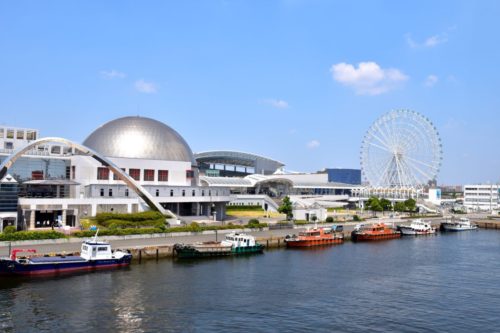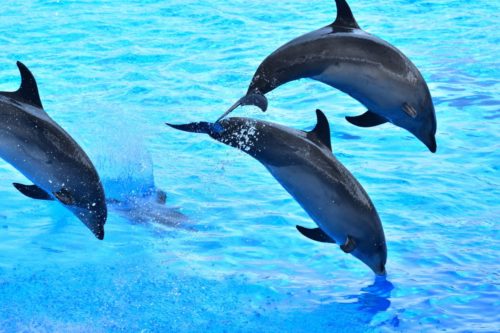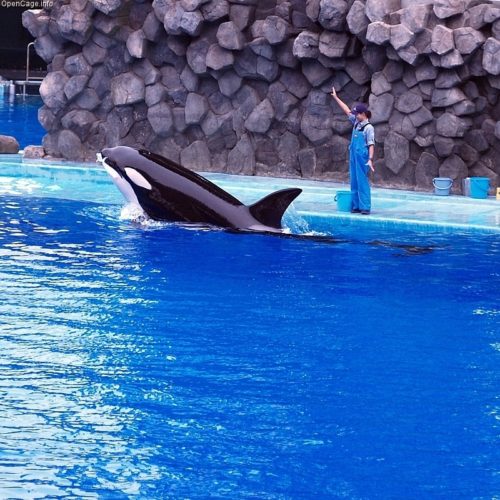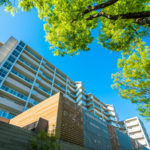Top 4 Things to Do at the Port of Nagoya Public Aquarium | Must-See Events and How to Get There
2019.05.16
- Tags:
-
The Port of Nagoya Public Aquarium is one of the largest facilities of its kind in Japan. It’s rare sea creatures and unique events have established the aquarium as one of Nagoya’s biggest tourist attractions.

There are so many animals for you to see and interact with at this marine paradise that you won’t know where to start.
Here we’ve listed everything you need to know about the aquarium, including information about the special shows and events, how much it costs to get in, and how to get there. A must-read if you’re planning a visit to Nagoya!
Contents

1. Port of Nagoya Public Aquarium
The Port of Nagoya Public Aquarium boasts over 500 marine species and a total of more than 50,000 creatures. Its main attractions are the killer whales and dolphins. You can see them up close during their designated shows and training events.
The aquarium also breeds various rare creatures, such as the beluga, which can only be found in five facilities throughout all of Japan.
You’ll also find a huge school of tornado-creating sardines and unique exhibits that let you see what the marine world is like on the sea floor. From tropical coral reefs to penguins and seals, visitors are able to interact with animals from all around the world. Note that the South Building and North Building each have different exhibits for you to explore.
But that’s not all this aquarium has to offer. For example, you’ll find exhibits of real skeletal models showing the evolution of marine creatures.
Visitors can even get in touch with certain animals and feed them. These activities are especially popular among couples and families with kids.
2. Top 4 Attractions at Port of Nagoya Public Aquarium
The Port of Nagoya Public Aquarium is one of the largest facilities of its kind in Japan and offers unique exhibits of various marine life.
Here are the top four attractions you don't want to miss that make the aquarium so special.
2-1. One of Japan’s Largest Dolphin Shows
The aquarium boasts one of Japan’s most impressive dolphin shows, held in a giant 60×30×12 meter pool. The performance lives up to its spacious venue, which can accommodate an audience of up to 3,000.
In addition to the main tank, there’s also a giant screen in the center of the stage that lets guests enjoy the facial expressions of the dolphins from anywhere in the stands.
You’ll also learn loads, as the knowledgable staff will tell you all about the animals in between acts.

2-2. The Coral Tunnel Tank
All of the exhibits at the aquarium are unique, but especially eye-catching is the tunnel tank. The top of this tank has an open ceiling which allows sunlight to stream directly into the water, creating a mighty mystical sight.
The tunnel tank also boasts real living coral. Coral is known to be difficult to manage as they can only live in certain environments, and being able to see these delicate invertebrates up close is just another great reason to visit the Port of Nagoya Public Aquarium.

OLYMPUS DIGITAL CAMERA
2-3. The Kuroshio Tank
The third must-see attraction is the Kuroshio Tank and its sardines. The giant exhibit boasts a school of 35,000 sardines. Watching them swim by is an experience that is nothing less than amazing.
A few times every day, an event called the “Tornado” is held here. When the sardines are fed, they all move at once creating a rare sight that looks similar to a tornado.
This can be seen twice a day on weekdays and six times a day on holidays. Each performance is about five minutes long.

2-4. Skeletal Models of Marine Creatures
It’s not just living fish you can see at the Port of Nagoya Public Aquarium. Skeletal models of marine creatures showing how they evolved through time are also popular.
The skeletons of whales and orcas here are real. You’ll even find a replica of the ancient Amublocetus, an ancestor of the present day whale.
Visitors can learn a great deal about whales and dolphins from the informative touch panels. It’s a great opportunity to have fun while you familiarize yourself with the mesmerizing world of marine life.
3. Must-See Events at Port of Nagoya Public Aquarium
The dolphin show isn’t the only performance the aquarium offers. There are many events displaying the natural habits of various creatures that you wouldn’t be able to see elsewhere.
Here are some of the must-see events and performances at Port of Nagoya Public Aquarium.
3-1. Performance Training
Performances by the animals as well as the training for them are popular events here at the aquarium. In addition to the dolphin show, visitors can watch belugas and killer whales in training.
The fifteen-minute public training comes with detailed commentary by an aquarist. Like the dolphin, belugas and killer whales are highly intelligent animals. You’ll love watching them play with toys or doing some tricks.
3-2. Feeding Time
Visitors can watch different creatures enjoying their meals. Some of the animals that offer feeding shows include the sardine in the Kuroshio Tank, the spotted seals, and the penguins. The staff will describe all about your favorites animals during these performances.
There’s only a fence, no glass, between you and the spotted seals at the Goma-chan Deck. Get up close to see their expressions!
4. Admission Fees and How to Get There
Here are the details about admission fees and how to actually get to Port of Nagoya Public Aquarium.
The business hours at the aquarium vary depending on the season so it’s important to check before you go. Tickets can also be purchased at convenience stores.
If you’re planning on visiting during the high season, you might want to get your tickets beforehand at a nearby convenience store.
4-1. Hours and Closed Days
Business hours vary depending on the time of year.
The aquarium is usually closed on Monday, but if a holiday falls on a Monday, the following Tuesday will be closed instead. Don’t forget to confirm it’s open before you go.
|
|
Date |
Hours |
|
Regular |
Late March - November |
9:30 - 17:30 |
|
Golden Week / Summer Break |
Late April - Early May (Golden Week) Late July - September 1 (Summer Break) |
9:30 - 20:00 |
|
Winter |
December - Mid March |
9:30 - 17:00 |
|
Closed |
None during July - September, New Year holiday, and Spring Break. Possibilities of temporary closure and maintenance work |
Every Monday *The following Tuesday is closed if a holiday falls on a Monday |
Be careful to time your visit carefully as hours change depending on the time of year.
You’ll probably find a crowd in the early hours from September to November because these are popular months for school field trips. If you’re planning to come by during these months, we recommend visiting in the afternoon when the crowds have dispersed a little.
4-2. Admission Fees
Admission fees are as follows. Children age three and younger are admitted free.
〇Individual
|
|
Adult |
High School Student |
Elementary / Middle School Student |
Child (age 4 and older) |
|
Regular |
2,000 yen |
2,000 yen |
1,000 yen |
500 yen |
|
Nighttime Admission (After 5 PM during GW and Summer Break) |
1,600 yen |
1,600 yen |
800 yen |
400 yen |
〇Group of 20 or More
|
|
Adult |
High School Student |
Elementary / Middle School Student |
Child (age 4 and older) |
|
20 or More |
1,800 yen |
1,600 yen |
800 yen |
400 yen |
|
100 or More |
1,600 yen |
1,400 yen |
700 yen |
350 yen |
You can skip the line and enter the aquarium faster if you pay for and obtain your ticket at a nearby convenience store before visiting.
Other options like annual passes are also available. The Transportation Bureau provides discounts with tickets like the Donichi Eco Kippu (Weekend Eco Ticket) as well.
4-3. How to Get There
You can reach the Port of Nagoya Public Aquarium by car as well as by public transport.
〇By Car
|
From Komei IC |
Continue straight from Komei IC toward Tsukiji-guchi / Port of Nagoya. |
|
|
From Meiko-chuo IC |
Turn left at the Meiko Chuo IC exit, continue along the road toward Tsukiji-guchi. Turn right at the Tsukiji-guchi intersection and continue straight. |
|
|
From Odaka IC |
Continue straight from the Odaka IC exit toward National Route 23 Yokkaichi, exit Tsukiji-guchi IC. Turn left at the Tsukiji-guchi intersection and continue straight. |
〇By Train
|
From Nagoya Station |
・Transfer at Sakae Station of the Higashiyama Line. Meijo Line toward Kanayama bound for Nagoyako. Alight at Nagoyako Station. Five-minute walk from Exit 3. |
|
|
・Alight at Meitetsu / JR Kanayama Station, transfer to the subway Meiko Line toward Nagoyako. Alight at Nagoyako Station. Five-minute walk from Exit 3. |
||
|
From Chubu Centrair International Airport |
Alight at Kanayama Station of the Meitetsu Tokoname Line. Transfer to the subway Meiko Line toward Nagoyako. Alight at Nagoyako. Five-minute walk from Exit 3. |
If you’re visiting by car, you can use the Garden Futo Parking Lot or the Garden Futo Nishi (West) Parking Lot. Both charge 100 yen per 30 minutes, and 1,000 yen for up to 24 hours.
Also, if you want to stay nearby during the peak season, consider booking your accommodation early.
In Conclusion
The Port of Nagoya Public Aquarium is one of Japan’s largest tourist attractions. You won’t be disappointed by the impressive orca and dolphin shows.
Remember that you can buy your ticket at a convenience store before your visit to save time upon entrance. And don’t forget to book your accommodation ahead of time if you want to spend the night nearby.
Now it’s time to go and enjoy all that Nagoya’s favorite aquarium has to offer!
Share this apartment details











